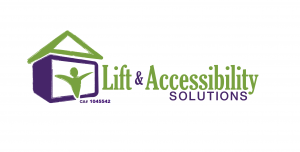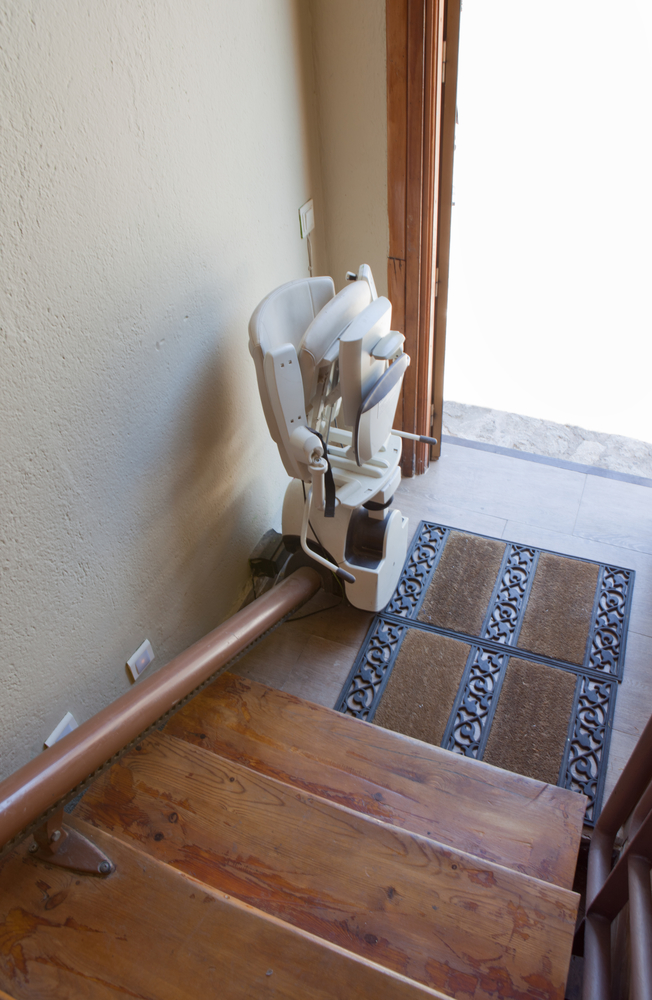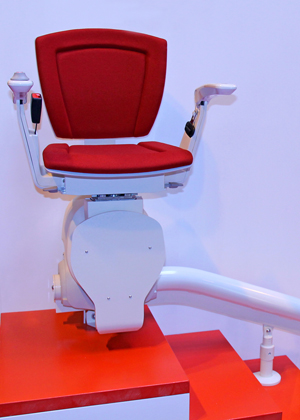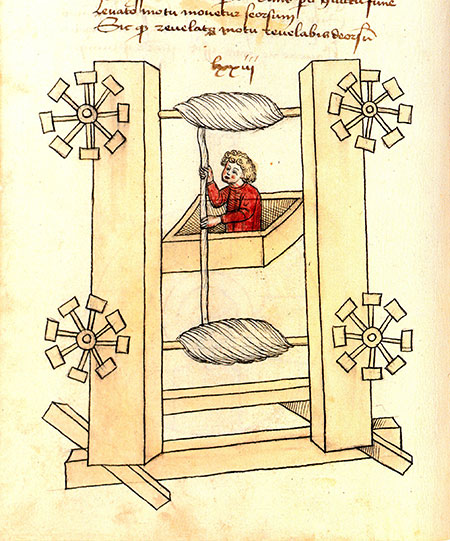As we and our loved ones age, mobility begins to become more of an issue with each passing year. Old injuries, the progress of arthritis, loss of balance, and various other aspects of a normal aging process start to limit what we can do and where we can go, even within our own homes. Persons with physical disabilities may also find that they are unable to move freely throughout their home and need some extra help getting around. For many, installing a lift in their multi story home restores a great deal of their mobility and independence. Let’s take a look at the different types of lifts and how each can help seniors and the disabled regain both their mobility and their freedom to move around their home.
Stairlifts
Quite possibly the most popular accessibility lift option, stair lifts offer many options and features that allow installers to customize them to the individual needs and home of the user. A sturdy rail support with a folding seat is installed on the wall of a staircase leading to the floor to which the user needs easier access. Powered by an electric motor, these lifts allow anyone to sit on the folding seat and ascend or descend the staircase without needing to climb the steps themselves. Stairlifts and accessories can also be matched to the decor of your home without compromising the style or aesthetic as well. Best of all, in addition to being one of the most versatile home accessibility lift options, stairlifts are also among the most economical options, too.
Wheelchair Lifts
While somewhat bulkier than stairlifts, wheelchair lifts offer the ability to make every floor in your home wheelchair accessible. Like a stairlift, wheelchair lifts have a folding platform mounted to a sturdy rail system installed in the wall of the staircase. Users unfold the platform and maneuver their chair onto it, usually securing themselves and their chair via an installed stability bar or similar mechanism. All that remains is a push of the “up” button, and they can be on the second floor independently in seconds. Wheelchair lifts can also be customized to better suit the decor and aesthetics of your home, allowing you to make them less visually obtrusive.
Personal Elevators
For those who have stairways too narrow for stair or wheel chair lifts, personal elevators make an excellent option. These unique lifts do not require a shaft to function, and can be installed directly through floors to reach levels of the home above or below them. These are an exceptionally quiet and safe option for users who use a wheelchair or for whom stair climbing and descent are no longer an option. Personal elevators also allow users to place them more discreetly within their home to keep their interior design and decor intact, too. While they are probably the most efficient option that requires the least amount of home renovation, they can be significantly more expensive than stairlifts or wheelchair lifts.
All in all, no senior or person with physical disabilities need limit their independence due to a loss in mobility. A stairlift, wheelchair lift, or personal elevator restores your personal independence and make every floor of your home easily accessible once again.
For many of us, owning a chairlift at some point during our lives has made it possible to travel up and down stairs when it was no longer physically possible. For some of us, however, there comes a time when we no longer need it.
This may be due to recovery from an injury or a recent remodel to the home that no longer accommodates the current chairlift, requiring a replacement. Maybe it no longer works. Maybe it was not you who used it, but an older friend or family member who moved to a nursing home or passed away, and now there is no need for a chairlift in the home. The list could go on.
The Challenge
Unfortunately, getting rid of an unneeded chairlift is a surprisingly difficult task. There is often little secondhand purchase value for chairlifts, so simply reselling them is not always the best option. Of course, it never hurts to look into the list price, just in case.
The Options
Depending on your area, you may be able to sell some parts for scrap metal, or a company may be willing to come uninstall your model for free or a small fee. A quick web search may pull up such companies in your area, but be aware of scammers and illegitimate businesses. If you believe you’ve found a reputable service, be sure they know how to handle the electrical wiring aspects of the chairlift removal. Otherwise, your free removal service may end up needing costly repairs.
If you have the information, you may be able to contact the company you purchased the chair from; some may be willing to purchase and/or remove it from your home to refurbish it, or to use working parts for repairs on other models. This could likely be your best option, as the company likely has the most experience and familiarity with your model.
If there is a shop in your area that sells items for elderly and disabled people, they may be aware of other options. It doesn’t hurt to stop in or give them a call.
Facilities who recycle and dispose of items like older appliances and televisions may be willing to accept your chairlift. Your options will vary, depending on the area you live in; if you are unsure, it never hurts to call around.
As useful as chairlifts are, they are not typically objects in high demand, making them difficult to sell or dispose of. Still, the task isn’t impossible; someone can likely make use of your chairlift if you do some looking around. Usually, your best option will be to search around the available services in your area and make phone calls until you find an interested party.
Installing a stairlift system in your home can be a substantial financial investment that, if cared for properly, will last a lifetime and provide those who need assistance quick and easy access to all parts of your home. There are several things that you can easily overlook that can quickly shorten the life of your stairlift. Many of these things are simple and easy to forget and can result in a broken or poorly running lift. Here are a few examples of things that are often overlooked that can have dire consequences in the long term for your stairlift.
Exceeding Your Stairlift Weight Limit
Probably the quickest way to run your stairlift to an early grave is to run the unit beyond its weight capacity. It can be very tempting to use your stairlift to carry heavy loads from one floor to another. Just ensure that you do so in both a safe manner and do not go over the stairlifts weight limits. Running your stairlift over its maximum weight limit can stress the entire system, potentially resulting in damage to the unit that can both take time and be costly to repair.
Poor Cleaning Habits
Simple cleaning habits can go a long way in extending the life of your unit. Keeping the lifts seat clean and free of dust and debris with the proper cleaning products can help keep the material from cracking or ripping for years to come. Stairlift track cleaning is easily overlooked, and the track can quickly build up dust that will over time make your unit work harder and less efficiently. Dust buildup can also contribute to stiff running tracks that will need to be lubricated to continue to run smooth.
Skipping Services
Skipping regular maintenance on your stairlift for one reason or another might not seem like a big deal. The reality is that each time you put off a scheduled service or maintenance, you are overlooking an opportunity to find any problems that might be addressed before they become larger issues. As is often the case with mechanical devices, problems start as something minor. Maintaining a regular service and maintenance schedule helps catch minor issues before they become major ones, as well as keeping your unit minor issue free.
With regular service and maintenance, attentive cleaning habits, and staying within the maximum weight limits of your unit, you can look forward to your stairlift having a very long life.
08 Apr 2017
When to Call a Professional to Repair Your Lift
If your home’s stairway chair lift or in-home elevator suddenly stops working, it would be natural to assume that something has gone wrong. Your first inclination may be to call a company professional to repair it, and really, you can’t go wrong with that option. Regardless of what the problem ends up being, an expert will be able to quickly identify the source of the malfunction, and troubleshoot it with little difficulty.
There are some circumstances where you may be able to investigate and address the problem yourself, depending on your technical skill level and the complexity of the issue. A word to the wise on this point: take care not to void your lift’s warranty! Review the warranty documentation that came with your lift carefully before attempting repairs of any sort by yourself. If you come to a point where any further attempts at troubleshooting would potentially render your warranty void, stop immediately and call a professional.
If the problem is simple, on the other hand, you may be able to resolve it quickly without any need for a service call. Some common problems that are easy to identify are whether the battery is charged or whether the safety switch is turned off. If the battery is the issue, you’ll be able to know it because there should be an indicator light somewhere showing whether the battery is charged or charging. If that light is turned off completely, the battery is not charged at all, nor is it recharging. This is a point where you should call for repairs under warranty. If the safety switch or key is turned off, it would automatically prevent the lift from operating, as it’s designed to do. Check the switch and make sure it’s turned on, then attempt to operate the lift again.
If the lift still isn’t working, then there may be a problem with one or more of the lift’s safety edges designed to prevent the lift from running into damaging obstacles. Make sure that, in fact, no obstacles are blocking the lift, then see if any of those safety edges are stuck or otherwise unmovable. If they are, it may then be the location of the problem. If all of these common features of your stairlift appear to be in working order, but the lift still isn’t moving, then it’s very likely that it will need the attention of a repair professional from the original installation company.
07 Feb 2017
Installing a Chairlift in Your Home
Earlier, we discussed pricing, options, and other information about installing an elevator in your home. Today, we’re going to look at an option that appeals to many people because, in part, is a more economical choice: installing a chairlift.
What Is A Chairlift?
A chairlift is pretty much exactly what it sounds like: it is a motorized chair installed on a special rail system. Like an elevator, it is designed to help move its occupant safely, quickly, and conveniently up or down a floor in a building. Unlike an elevator, though, which requires a special area to be built to house the elevator cab as well as other modifications, a chairlift is a relatively easy installation because it is designed to smoothly travel up or down a flight of stairs. This means that the chairlift installation is a much easier process than an elevator, and even better: it tends to be much cheaper as well.
What Are The Types Of Chairlifts?
Generally speaking, there are two types of chairlifts (also known as stair lifts, or stair chairs) to choose from, and the choice depends on what type of staircase you already have in your home. Straight chairlifts are installed on a straight staircase that simply goes up and down in a straight line. Curved chairlifts are installed on a curved staircase. Because curved staircases are generally unique in their design, a curved chairlift usually requires a little bit of customization, which can affect the overall price.
Installation And Price
Typically, a straight chairlift is a straightforward process (no pun intended). As most chairlifts are already constructed before you purchase them, there is very little time between buying one and its installation. Permits will be required, and are a separate charge.
As many staircases, even straight ones, can be a little different when it comes to things like angle of descent, etc., it does take a little bit of adjusting to make sure the rail system is installed properly. In addition, details such as stair material can influence the difficulty of the installation, and, therefore, the price. If the stairs have unusually long steps, platforms, or are situated far from an electrical source, those factors can also have an impact on the bottom line.
Curved lifts are a little trickier. In this case, the railing system often needs to be custom-made to fit the particular needs of your staircase. This can also affect the price. Other things that can alter the price include the quality of the chair itself, the motor you wish to install (which will have an impact on the final speed of the chair), and any other customization you wish.
In the end, though, installing a chairlift is a relatively easy and cheap process that can help restore mobility and independence. If you are interested in learning more about the process and how we can help you, please don’t hesitate to contact us today!
30 Aug 2015
What to Expect When Getting a Chair Lift
For many Americans, mobility is the key to life. While most of us don’t think about it too much, the ability to move around and go wherever you want is something innate to our sense of freedom. It isn’t until our mobility is limited, either from old age, disease, or disability, that we realize how important it is. Fortunately, there is a wide selection of options for those who have limited movement, especially when it comes to your home. Where you live should be a comfortable, safe space where limited functions shouldn’t hinder your ability to enjoy life. Unfortunately, those who have mobility concerns have to adjust themselves when their home has multiple stories, as getting up and down the stairs can be difficult.
There are several options available for anyone who needs assistance with stairs. Today we’re going to discuss chair lifts in particular. A chair lift runs on a mechanized track, carrying you and possibly any other items you need up and down the stairs. The benefit of a chair lift is that it can run alongside the stairs, so it isn’t as cumbersome or intrusive as other options, like an elevator.
When considering a chair lift, you need to consider several things, cost, size, and personal needs.
Cost
Some insurance carriers can help cover the costs of installing a chair lift, so that can be an enormous relief. You need to check with your carrier and the company who makes the lift to find out what financing options are available. However, the cost of ownership isn’t just limited to installation, as lifts require routine maintenance over the years. Try to purchase a lift from a manufacturer that also provides service, for efficiency and savings.
Size
Not all lifts are created equal. You should consider the size of the staircase, the size of the chair itself, and the size of your person. Most installers will come out to do an inspection to make sure that installing one is feasible.
Personal Needs
This is obviously going to be your top priority when deciding about a lift. Everyone has their own mobility needs, so you need to figure yours out before moving forward with installation. This can include whether or not you need a wheelchair to get around, as it will need to ride the lift with you, whether you need assistance getting in and out of the lift, and how frequently you would need to use it in the first place. Once you’ve answered these questions, you’ll be much better prepared when it comes time to choosing a lift to meet those needs.
31 Jul 2015
A History of Elevators in The Home
For a long time, mankind has looked for new, efficient ways to make our lives easier. From the wheel to electricity, advances in industry and technology have enabled us to achieve what would have previously been thought impossible. One such invention that revolutionized transportation is the elevator. Taken for granted today, the elevator is something that allowed us to take to the skies; no longer were we limited to having buildings with only a couple floors. As the world’s population exploded, it was necessary for our survival to make taller and taller structures to hold us.
For the most part, elevators were a simplistic lift device, with some sort of counterweight to balance the load. It wasn’t until 1852 that Elisha Otis invented the safety lift, which implemented a device that would lock in place should the cables ever break down. In part due to the increased safety measures and better medical care, it didn’t take long before elevators were installed for personal use in the home.
For a long time, installing a lift in your house was a costly process, requiring a pulley system to be built and a full car and cables to be implemented. For this reason, home elevators were relegated to only the wealthy. However, as technology improves and adapts, putting a lift in your home is now a relatively reasonable expense. This is mostly in part because there is now a variety of options to choose from when deciding a lift for your needs. There are chair lifts, hydraulic lifts, pneumatic lifts, and the standard pulley system. Because of the variety of options, lifts are available where previously it would not have been an option. Many lifts can fit within a smaller space, allowing anyone to install an elevator, no matter what their situation.
Today, there are companies that can provide a simple tube lift for only a few thousand dollars. A company based in Argentina has perfected the pneumatic model, allowing a single unit to be installed quickly and relatively inexpensively. The elevator uses vacuum technology to ascend and descend the cab, making it quieter, smaller and more versatile than traditional lifts. As demand increases with the large amount of baby boomers reaching retirement age, the technology will only get better and less expensive. There could be a day when an in home lift could be as common as a fireplace.











